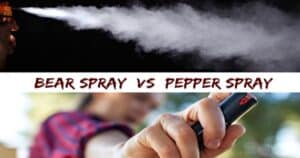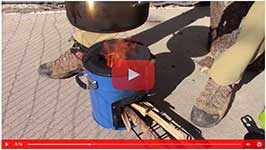 Today, we’re talking about Bear Spray Vs Pepper Spray.
Today, we’re talking about Bear Spray Vs Pepper Spray.
Both are powerful tools in the right hands, but which should you carry in your bug-out bag or have ready at home?
Let’s break it down from every angle to ensure you’re well-prepared for anything coming our way.
TOPICS IN THIS GUIDE… ↓(click to jump)

Click here to instantly download this Complete Checklist PDF. No purchase necessary.
Bear Spray Vs Pepper Spray Comparision Chart

Understanding the Basics
First things first, let’s get clear on what we’re dealing with…
Bear Spray
Bear spray is a type of aerosol deterrent designed to ward off aggressive bears.
It’s a non-lethal, highly effective tool that can stop a charging bear in its tracks by creating a large cloud of irritating spray.
The active ingredient in bear spray is capsaicin and related capsaicinoids, the same stuff that gives chili peppers their heat.
Pepper Spray
Pepper spray, also known as OC (oleoresin capsicum) spray, is a defensive tool used for personal protection against humans and animals.
It’s commonly carried by law enforcement and civilians for self-defense.
Like bear spray, its active ingredient is capsaicin, but the concentration and delivery method can differ.

Click here to instantly download this Complete Checklist PDF. No purchase necessary.
Key Differences
Let’s talk about what sets these two sprays apart.
Purpose
Bear spray is specifically formulated to deter bears.
It’s designed to create a wide, fog-like spray that can cover a large area and is effective from a distance of about 20-30 feet.
The goal is to create a barrier between you and the bear, giving you time to escape.
Pepper spray, on the other hand, is meant for self-defense against humans and sometimes dogs.
It typically has a more concentrated stream and a shorter range, around 10 feet.
The idea is to aim directly at an attacker’s face, causing immediate pain and temporary blindness, allowing you to get away.
Concentration
Bear spray generally has a lower concentration of capsaicinoids (1-2%) compared to pepper spray (up to 10%).
This might seem counterintuitive, but bear spray’s lower concentration is offset by its higher volume and broader spray pattern.
It’s like comparing a
Spray Pattern
Bear spray produces a wide, fog-like spray, which is crucial for hitting a large target like a charging bear.
This pattern increases your chances of hitting the bear’s face, even if your aim is off.
Think of it as casting a wide net to catch the big fish—or, in this case, the big furry beast.
Pepper spray usually emits a narrow stream, gel, or foam designed to target an attacker’s face with precision.
Some models offer a cone or fog pattern, but these are less common.
It’s more like threading a needle, which is great if you’re a sharpshooter under pressure.
Range
Bear spray has a longer range, typically 20-30 feet, giving you more distance from the threat.
Pepper spray’s range is shorter, usually around 10 feet, reflecting its intended use in close-quarters self-defense.
In other words, bear spray lets you distance yourself from an angry bear, while pepper spray is for when your personal space gets seriously invaded.
Effectiveness
How well do these sprays work in real-world scenarios?
Bear Spray
Bear spray is highly effective at deterring bear attacks.
Studies have shown that bear spray stops bear aggression in over 90% of cases.
The large, expanding cloud it creates is hard for a bear to avoid, and the effects are immediate, causing the bear to retreat.
However, bear spray is not foolproof.
Wind can affect its delivery and might not be as effective against other types of wildlife or humans.
Plus, you must be aware of how to use it properly, as a missed spray can leave you vulnerable.
↓ Bear Spray Scenarios & Demonstration
Pepper Spray
Pepper spray is also highly effective, with a success rate of about 85-90% in stopping human attackers.
The immediate pain, inflammation, and temporary blindness it causes can incapacitate an assailant long enough for you to escape.
It’s like a pocket-sized superhero, ready to save the day.
Like bear spray, pepper spray can be affected by wind, and its effectiveness can vary based on the individual’s pain tolerance, state of mind, and substances they might be under.
Additionally, some attackers might still be able to fight through the pain.
So, it’s not a guaranteed knockout, but it’s a solid jab.
↓ The Effects Of Pepper Spray
Understanding Capsaicin Concentration
Capsaicin concentration in self-defense sprays varies widely, and this concentration directly impacts the intensity of the spray’s effects.
Generally, self-defense sprays, including both bear and pepper sprays, contain oleoresin capsicum (OC), which is the oil extracted from chili peppers and standardized for capsaicin content.
The higher the capsaicin content, the hotter and more effective the spray.
Capsaicin Concentration in Bear Spray
Bear sprays typically have a capsaicin concentration of around 1-2%.
While this might seem low compared to pepper sprays, the volume and delivery method make bear spray incredibly effective.
Bear sprays are designed to create a large cloud of mist that covers a wide area, ensuring that the bear inhales and is affected by the capsaicin.
This lower concentration can cause intense discomfort and drive away a charging bear without causing permanent harm.
Capsaicin Concentration in Pepper Spray
Pepper sprays for self-defense against human attackers usually have a higher capsaicin concentration, ranging from 1-10%. Here’s a breakdown of the different heat levels commonly found in pepper sprays:
- Low Concentration (1-2%): These sprays are effective but may require more direct hits to the face to achieve the desired effect. They are often used in situations where there is a higher risk of accidental exposure to bystanders or where legal restrictions limit the maximum concentration.
- Medium Concentration (3-5%): This is the most common concentration range for pepper sprays marketed for personal self-defense. It provides a good balance of potency and safety, making it effective at incapacitating attackers quickly without posing significant risks of severe injury.
- High Concentration (6-10%): These sprays are extremely potent and can cause severe burning sensations, temporary blindness, and difficulty breathing. They are typically used by law enforcement and individuals who want the maximum stopping power available. However, the high concentration increases the risk of prolonged recovery times and potential legal issues if misused.
Scoville Heat Units (SHU)

The potency of self-defense sprays is often described in terms of Scoville Heat Units (SHU).
Here’s how SHU correlates with the effectiveness of the spray:
- Up to 2 million SHU: This level is typical for high-concentration pepper sprays used in personal defense and law enforcement. The effects are immediate and intense, causing significant pain and temporary incapacitation.
- Around 1 million SHU: This is a common SHU level for medium-concentration pepper sprays. It provides a strong deterrent effect while maintaining a balance between potency and safety.
- 500,000 to 1 million SHU: These sprays are still very effective but are often marketed towards civilian use with slightly less intensity to minimize potential legal and health risks.
Bear sprays usually have SHU levels around 1-2 million, similar to high-concentration pepper sprays. Still, the delivery method ensures that the capsaicin is dispersed over a large area, making it suitable for deterring large animals.
↓ Peppers On The Scoville Scale


Get My 10 Steps To Basic Preparedness Video For FREE.
Plus daily survival tips (unsubscribe anytime).
Read the full article here



